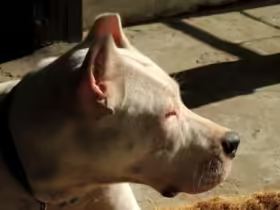Lactose intolerance is a common condition that affects many animals, including dogs. Just like in humans, lactose intolerance in dogs can cause discomfort and digestive issues. As a responsible pet owner, it’s important to understand whether your dog is lactose intolerant, what symptoms to watch for, and how to manage their diet to ensure their health and well-being. In this comprehensive guide, we’ll explore the ins and outs of lactose intolerance in dogs, including its causes, symptoms, and how to handle it effectively.
1. What is Lactose Intolerance?
Lactose intolerance occurs when an animal’s digestive system lacks sufficient levels of lactase, the enzyme needed to break down lactose, a sugar found in milk and dairy products. Without enough lactase, lactose cannot be properly digested and absorbed, leading to gastrointestinal issues.
1.1. How Lactose is Processed
- Lactase Enzyme: In a healthy digestive system, lactase breaks down lactose into simpler sugars, glucose, and galactose, which can be absorbed into the bloodstream.
- Lactose Malabsorption: If lactase levels are insufficient, lactose remains in the intestines where it ferments, causing bloating, gas, and diarrhea.
2. Are All Dogs Lactose Intolerant?
Not all dogs are lactose intolerant, but many are to varying degrees. Lactose intolerance is more common in adult dogs, as the production of lactase generally decreases after weaning.
2.1. Puppies vs. Adult Dogs
- Puppies: Puppies are born with the ability to digest lactose because they need it to process their mother’s milk. As they grow and are weaned, their lactase production typically decreases.
- Adult Dogs: Many adult dogs have reduced lactase levels, making them more likely to experience lactose intolerance when consuming dairy products.
3. Symptoms of Lactose Intolerance in Dogs
If your dog is lactose intolerant, you may notice several symptoms after they consume dairy products. These symptoms can vary in severity depending on the amount of lactose consumed and the individual dog’s tolerance level.
3.1. Common Symptoms
- Diarrhea: One of the most common symptoms of lactose intolerance in dogs is diarrhea. The undigested lactose in the intestines can cause loose stools and frequent bowel movements.
- Vomiting: Some dogs may vomit after consuming dairy products, especially if they have a severe intolerance.
- Bloating and Gas: Lactose fermentation in the intestines can lead to bloating and excessive gas, causing discomfort for your dog.
- Abdominal Pain: Dogs may exhibit signs of abdominal pain, such as whining or restlessness, due to gastrointestinal distress.
4. Diagnosing Lactose Intolerance in Dogs
Diagnosing lactose intolerance can be challenging as the symptoms can be similar to other gastrointestinal issues. However, there are several methods to determine if your dog is lactose intolerant.
4.1. Observational Method
- Elimination Diet: Remove all dairy products from your dog’s diet and observe whether their symptoms improve. If symptoms subside when dairy is removed, it may indicate lactose intolerance.
- Controlled Testing: Introduce small amounts of dairy back into your dog’s diet and monitor for any adverse reactions. Gradually increasing the amount can help determine the level of intolerance.
4.2. Veterinary Testing
- Breath Test: Some veterinarians use a hydrogen breath test to diagnose lactose intolerance. This test measures hydrogen levels in the breath after consuming lactose.
- Stool Analysis: A stool sample may be analyzed for undigested lactose or other markers of gastrointestinal distress.
5. Managing Lactose Intolerance in Dogs
If your dog is diagnosed with lactose intolerance, managing their diet is crucial to avoid discomfort and health issues. Here are some strategies for managing lactose intolerance in dogs.
5.1. Avoid Dairy Products
- Eliminate Dairy: The most effective way to manage lactose intolerance is to avoid feeding your dog dairy products altogether. This includes milk, cheese, yogurt, and other dairy-based treats.
- Read Labels: Be cautious with processed foods and treats that may contain dairy ingredients.
5.2. Alternatives to Dairy
- Lactose-Free Products: Some lactose-free dairy products are available, but it’s best to consult with your veterinarian before introducing them to your dog’s diet.
- Dog-Safe Treats: Provide your dog with treats specifically formulated for dogs, which do not contain dairy or other problematic ingredients.
5.3. Gradual Introduction
- Test Tolerance: If you wish to introduce dairy into your dog’s diet, do so gradually and in small amounts. Monitor your dog for any adverse reactions and adjust accordingly.
6. Can Dogs Have Dairy at All?
While some dogs may tolerate small amounts of dairy, it’s generally safer to avoid giving them dairy products altogether, especially if they have shown signs of lactose intolerance.
6.1. Limited Dairy Consumption
- Small Amounts: In some cases, a small amount of cheese or yogurt may be tolerated by dogs with mild lactose intolerance. However, it’s essential to observe your dog’s reaction and consult with your veterinarian.
- Non-Dairy Alternatives: Consider non-dairy alternatives like dog-safe fruit or vegetable treats to avoid potential issues.
7. Preventing Lactose Intolerance Issues
Preventing lactose intolerance issues involves understanding your dog’s dietary needs and making informed choices about their food. Here are some tips to help prevent problems associated with lactose intolerance:
7.1. Educate Yourself
- Know the Signs: Be aware of the symptoms of lactose intolerance so you can take prompt action if your dog experiences digestive issues.
- Consult Your Veterinarian: Regular check-ups with your veterinarian can help identify and manage any dietary issues your dog may have.
7.2. Monitor Diet
- Maintain a Balanced Diet: Ensure your dog’s diet is well-balanced and free from unnecessary dairy products.
- Adjust as Needed: If you notice any changes in your dog’s health or behavior related to their diet, make adjustments as needed and seek veterinary advice.
Conclusion: Understanding and Managing Lactose Intolerance in Dogs
Lactose intolerance is a common condition in dogs that can cause a range of digestive issues. By understanding the symptoms, diagnosis, and management strategies for lactose intolerance, you can help ensure your dog’s comfort and well-being. Avoiding dairy products and providing a balanced diet tailored to your dog’s needs will help keep them healthy and happy.
If you suspect your dog may be lactose intolerant or if you have any concerns about their diet, consult with your veterinarian for personalized advice and guidance.











Leave a Reply